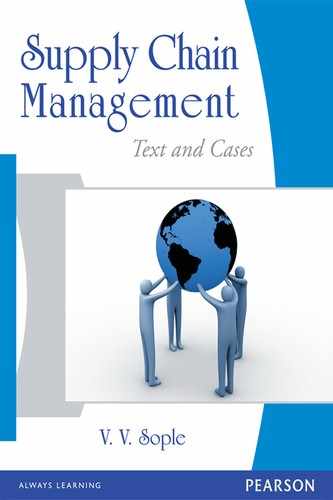Case 13
Zico
Suoolv Chain Initiative—Localization
ZICO was established in 1951 and today is one of the leading manufacturers of diesel fuel injection equipment in the world. In India, ZICO is having manufacturing facilities at three places. ZICO undertook SCM initiatives to achieve the overall profitability of the business by reducing the cost. Through the SC initiatives, ZICO integrated the three individual business processes of procurement, manufacturing and distribution.
Procurement
Procurment is one of the major cost drivers in ZICO's supply chain. The procurement cost is influenced by the following factors:
- The way procurement decisions are made
- Procedures adopted in the procurement process
- Relationship with the suppliers
- The firm's credibility
- Market intelligence
To control the procurement-related cost, ZICO went for e-Sourcing which streamlined workflows, enhanced flexibility and created transparency in the buyer-seller relationship. The e-procurement process improved the accuracy and availability of information on the supply and demand side, facilitating collaboration as well as control and compliance. E-sourcing freed up purchasing personnel to focus on more strategic concerns such as supply base development and relationship management, linking suppliers into up-front innovation processes and value chain restructuring. E-sourcing also helped in reducing the time to the market for the finished goods. ZICO took steps like supplier base optimization which resulted in various improvements in operational quality. The advantages were seen in reduced scheduling work, follow-ups and complexity. To reduce the cost of imported components, ZICO went in for ‘localization’ which resulted in huge cost benefits and reduced inventory levels of imported items. It helped in meeting the delivery requirements and reducing inventory cost substantially.
Processing
For developing a lean supply chain the emphasis was not on curtailing the processing/manufacturing cost through economies of scale, but on reducing the huge inventory-carrying cost resulting from mass production ahead of demand. In the past, the emphasis was on building mega-capacity factories to produce standard products in millions to reduce manufacturing cost and flood the market with low-priced products. The stress was on focused factories to manufacture standard products for the global consumption. ZICO initiated indigenization/ancillarization whose agenda was to indigenize suppliers and outsource non-critical operations. The company was interested in expansion for which this was very helpful. The company reviewed its make/buy decisions for retaining its core competence. It was good to outsource the non-critical accessories since the in-house cost of manufacturing was very high and further investments were not allowed. Product cost reduced considerably and production was doubled without employing extra labour and investments. Due to the implementation of indigenization and ancillarization, the employment growth increased by almost 50 per cent each year and also the sales turnover increased resulting in high productivity. One very important factor was optimum allocation of space, which was done very efficiently after implementing ancillarization. ZICO also tried to save on the cost of materials. As 70 per cent of ZlCO's cost came from the supply chain, the supply chain contributed significantly in reducing the cost of the materials. As per the suppliers suggestion ZICO used alternate materials and better processes. These reduced the material cost considerably. ZICO saw a very good reduction of 8 per cent in material cost after applying all innovative measures and means resulting in increasing the firm's profitability.
Distribution
Traditionally, the role of distribution in the business process is warehousing transportation. However, in the supply chain model the major task of distribution relates to the management of demand, that is, to make available the right product at the right place and at the right time and at the least cost. ZICO faced the challenge of bringing in world class suppliers quickly and also tracking and shrinking the life cycle of purchased parts. Quick product development was a must to survive in the fast changing world. ZICO took different steps to reduce the time to the market like supplier involvement, etc. The other benefits of supplier involvement include improved access to supplier technology, aligned technology road maps, and more innovative products. At ZICO, simultaneous engineering and rapid prototype development were being practiced to meet the ‘time to the market’. The company managed to reduce lead time for development from 90 to just 38 days, which is a significant achievement leading to gaining of market share by 15 per cent. Earlier the share was 8 per cent, which increased to 23 per cent.
Role of Logistics
ZICO has focused on the areas like inventory management, material handling and storage systems, and packaging. ZICO has outsourced its outbound logistics and warehousing to reduce costs and overheads. Further, ZICO monitored its inbound and outbound transport costs and made efforts to keep it at the desired minimum level by proper vehicle planning and selecting appropriate transporters. ZICO has also introduced the VMI (vendor managed inventory) which again reduces the transportation and the handling cost. ZICO introduced milk run to reduce the freight from the suppliers to the warehouse. Inventory was controlled using 3PL. This helped in reducing the cost of logistics to just 15 per cent of the total cost. The methods included outsourcing of inbound logistics, milk run, better vehicle planning and optimization of logistics chain in India. Recyclable bins and containers have led to additional cost reductions and enhanced customer satisfaction.
Results
The key business goals were achieved and SCM improved top line and bottom line as well. Further, ZICO set new benchmarks to achieve further reduction in cost and improvement in supply chain productivity. With the available infrastructure and all the endeavours of manpower in the organization, ZICO could excel and put up the name ‘Made in India’ in both domestic as well as international markets.
REVIEW QUESTIONS
- Discuss the various supply chain initiatives of ZICO.
- Explain how the manufacturing strategy evolved by ZICO helped in enhancing profitability.
- Explain the role of logistics in ZICO's supply chain strategy.
